Back to Journals » Journal of Multidisciplinary Healthcare » Volume 14
The COVID-19 Pandemic and Its Impact on Knowledge, Perception and Attitudes of Dentistry Students in Austria: A Cross-Sectional Survey
Authors Boukhobza S, Ritschl V , Stamm T , Bekes K
Received 17 March 2021
Accepted for publication 19 May 2021
Published 14 June 2021 Volume 2021:14 Pages 1413—1422
DOI https://doi.org/10.2147/JMDH.S311535
Checked for plagiarism Yes
Review by Single anonymous peer review
Peer reviewer comments 4
Editor who approved publication: Dr Scott Fraser
Sarra Boukhobza,1 Valentin Ritschl,2 Tanja Stamm,2 Katrin Bekes1
1Department of Pediatric Dentistry, University Clinic of Dentistry, Medical University Vienna, Vienna, Austria; 2Center for Medical Statistics, Informatics, and Intelligent Systems, Section for Outcomes Research, Medical University Vienna, Vienna, Austria
Correspondence: Katrin Bekes
Department of Pediatric Dentistry, University Clinic of Dentistry, Medical University Vienna, Sensengasse 2a, Vienna, 1090, Austria
Tel +43-1-400702801
Fax +43-1-400702809
Email [email protected]
Introduction: Universities with dental schools are faced with complex problems during the COVID-19 pandemic. Dentistry students are at a higher risk of contracting infections, specifically COVID-19, due to direct contact with patients. The aim of this study was to assess the knowledge, perception and attitude regarding COVID-19 among dentistry students in Austria.
Methods: During the first lockdown in Austria, an online survey was distributed among 165 dentistry students in their clinical term at the Medical University of Vienna. The survey contained elaborative questions on the general knowledge and attitude towards COVID-19. A special focus of the questionnaire was set on the modification of the student’s curriculum regarding infection control.
Results: In total, 77 (47%) students replied; 68 questionnaires were included in the analysis. Dentistry students were found to have good general knowledge of COVID-19 during the early phase of the pandemic. Most students (89.6%) got their information regarding the COVID-19 infection from official sources; however, 58% would like to attend further lectures on COVID-19 to expand their knowledge.
Discussion: The current study finds good general knowledge on COVID-19 among dental students, but some gaps regarding hygienic protocols and infection control. Students’ preferences regarding modification in the curriculum suggest practical courses and lectures as a way to close COVID-19 related knowledge gaps.
Keywords: COVID-19, pandemic, infection, dentistry students, infection control
Introduction
A novel coronavirus infected pneumonia, that was first detected in December of 2019, in Wuhan, China, was clearly defined by way of a real-time reverse-transcription polymerase-chain reaction (RT-PCR) by January 18, 2020.1 Named 2019-nCov, COVID-19 or more fully, severe acute respiratory syndrome coronavirus 2 (SARS-CoV-2), by March, it had spread so widely that the WHO declared COVID-19 a pandemic. The symptoms that COVID-19 displays include a high fever and cough, and in advanced cases, respiratory distress. Further symptoms that might be observed are nausea, vomiting, diarrhea, muscle-joint pain, and loss of appetite.2 In severe cases COVID-19 can lead to severe respiratory and kidney failure and result in death, where the median infection-fatality rate is 0.27%, but can vary locally between 0.05% and 1.31%.3 Transmission of this novel coronavirus occurs mainly via respiratory droplets and direct contact.4 Since COVID-19 can be detected in patients’ saliva, this suggests that dentists who need to work in close proximity to patients, where treatment also often involves the use of dental procedural aerosols face a greater risk of infection, although how great the risk of infection through dental aerosols is remains to be seen.5,6
Therefore, to minimize the risks that stem from patients who are in the incubation period, do not know that they are infected or actively conceal this fact may cancel out the effectiveness of the protective measures that are already in place.4 For this reason many clinics and private practices worldwide significantly reduced the treatment of patients as a response to the first wave of the pandemic to non-deferrable urgent care.7
In China, where the first cases of the virus were detected, Guo et al reported that 94.6% of the dental procedures during the first wave of the COVID-19 pandemic were mostly emergency cases.8 Due to international recommendations and actions of other countries, it was suggested by the Chamber of the Austrian Dentistry Society to suspend all dental treatments that are not categorized as emergency or urgent dental services and postpone elective dental procedures to a later time. The suggestions were inspired by the recommendations of the American Dental Association that refer uncontrolled bleeding, soft tissue bacterial infection, intraoral or extraoral swelling and trauma involving facial bones as a dental emergency. Urgent dental care treatments include severe pain caused by pulpal inflammation, dental trauma and tooth fracture.9
That this suggestion was taking seriously was confirmed by a survey among pediatric dentists in Austria.10 For those treatments that could not be deferred, guidelines were quickly published for the dental profession by the World Health Organization and several other leading institutions.11,12 In the university setting, a large part of dental practice is done by students that have reached their clinical term. This was put on hold during March and April as part of the lockdown measures in Austria. With students resuming on patient work, compliance with these guidelines poses additional challenges to the students and indirectly to the university. Dental students in their clinical term face, in general, greater exposure from viruses and infections since their clinical experience is still limited and the manual skills are not up to the same standards as trained dentists.13,14 This means that with regard to COVID-19, students might either be expected to inform themselves autonomously about the virus, its characteristic symptoms and the relevant disinfection protocols and other protective measures like the use of an FFP2 or FFP3 mask via the publicly available guidelines or the university might provide some means to inform its students by way of seminars, lectures or emails distributed via the university.15
This study is the first in Europe that aims to provide dental faculties, who want to make this decision in a more systematic and data-driven way, not only with the means to assess shortcomings with regard to knowledge about COVID-19 among dental students during the first months of the pandemic, but also with ways to target these educational shortcomings within the institution that are sensitive to the interests and motivations of the students themselves. The results of this study might also be of some use with regard to institutional responses in the event of future diseases.
Materials and Methods
Study Design
Austrian dentistry students participated in an online survey, that included a questionnaire to evaluate their knowledge, perception of the risks and attitude to activities in dental practice regarding COVID-19.
Setting, Participants and Sample Size
Potential participants were 165 dentistry students at the Medical University of Vienna in their clinical study period (1 and 6th year). The study was conducted in March of 2020 during the first lockdown caused by COVID-19 in Austria.
The internal review board of the Medical University of Vienna approved the study.
Data Sources and Variables
A self-developed questionnaire survey in German was used. It was designed using reference material and information sheets on COVID-19 developed by WHO, the Austrian Ministry of Health and the Center for Disease Control and Prevention. The questionnaire was developed by faculty members and experts in the field of dentistry, medical science, infection control and statistic. This group tested the content and validity of the questionnaire and assessed the accuracy of the questions. Based on the comments made by the selected experts, some questions were added and modified to enable better understanding. It contained 30 questions, of which a third were multiple choice questions, that were divided into the following sections: demographic information (3 questions), general knowledge regarding COVID-19 (12 questions) as well as attitudes, perceptions and practice toward the new virus (15 questions). At the time of the start of the study, there were no similar studies conducted to assess the knowledge on dentistry students. The prepared online survey was sent and made available to all dentistry students at the Medical University of Vienna in the clinical study period via www.soscisurvey.de. The students were invited to participate in this survey via mail, where the purpose of the data collection and its scientific value was explained. All students voluntarily participated in this study. Informed consent was obtained from all participants. Only fully completed questionnaires were considered. The data was obtained anonymously. Tracing the identity of the students was not possible.
Statistical Methods
Descriptive statistics were used to summarize and analyze the data. Absolute and relative frequencies, as well as measures of central tendency and dispersion were calculated as appropriate, depending on the scale level and distribution of each variable. Descriptive statistics were performed using SPSS Statistics Version 27 (IBM Corp).
Results
Sociodemographic Data and Profession-Related Characteristics
In total, 77 students participated. Since nine questionnaires were not filled out completely, they were not included in our analysis. With a response rate of 47% a total of 68 (88%) completely filled out surveys were included in the study. The majority of the participants were females (56%) (Table 1). Overall 72% of the respondents were 25–34 years old. The level of education ranged from the 9th to the 12th semester which results in all of the participants being enrolled in clinical courses. More than one-third of the students was in the 12th semester, followed by students of the 10th semester with 29%.
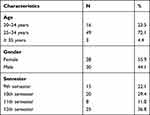 |
Table 1 Demographics of the Study Participants |
General Knowledge and Attitude Regarding COVID-19
Merely 15% of all respondents knew that the virus causing the novel coronavirus infection is called “2019-nCoV” (Table 2). Whereas the majority of the students (90%) correctly identified the name “Severe Acute Respiratory Syndrome Corona Virus-2 (SARS CoV-2)”. The results show that most students (83%) were aware of the fact that the infection can affect all age groups.
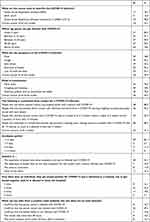 |
Table 2 General Knowledge Regarding COVID-19 |
About 31% of the respondents were able to identify all possible symptoms of the COVID-19 infection that where known to the time the study was conducted. All participants (100%) considered “Fever” an important symptom of the virus.
The questions about the mode of transmission of the virus (hand shake, coughing and sneezing, touching surfaces) was correctly answered by 64% of the students. However, all participant (100.0%) knew “coughing and sneezing” transmitted the virus.
93% of the participants also knew that people who had unprotected, direct contact with infectious secretions from a COVID-19 case could be considered as a being in close contact for a COVID-19 infection. The correct incubation period of 1 to 14 days was known to 83% of the students, even though 12% believed 2 to 5 days to be the right answer. The definition of isolation was known by 44% of the respondents.
As shown in Table 3 about 90% of the participants indicated that their sources of information about COVID-19 is gained from the Organizations of the Federal Government. The second most widely used source of information were other health professionals (50%) as well as social media (50%), while the least frequently used sources of information were the Austrian (23%) and German chamber of Dentists (10%). Table 4 includes the students general and personal perception of the novel virus. Generally, a total of 71% of participants estimated the virus to be moderately dangerous. However, if it comes to a personal risk assessment the opinions were divided. Roughly a third of the students thought that the risk of becoming infected is very dangerous, and 42% graded it as moderately dangerous. The answers to the question about whether the participants felt prepared for COVID-19 in Table 4, was equally distributed with 38% replying “Yes” and 33.3% answers with No or Not sure 29%.
 |
Table 3 Sources of Information |
 |
Table 4 Attitudes Towards COVID-19 |
COVID-19 and Dentistry
As seen in Table 5 and Figure 1, 46% of the dentistry students perceived the role of a dentist in teaching patients about COVID-19 as very significant. Despite this, only 44% knew of any COVID-19 guideline on infection control and a mere amount of 4% of the participants attended a seminar on COVID-19 infection control, though 40% would like to attend one as soon as possible. Table 6 shows results about how and to what extent students would like to integrate information on COVID-19 in to their curriculum. About 60% would like to attend lectures on COVID-19 to expand their knowledge and 42% are interested in practical training for protective measurements. Most participants (73%) want to integrate information about COVID-19 to a little extent into their curriculum, and only 15% to a great extent.
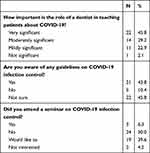 |
Table 5 COVID-19 and Dentistry in General |
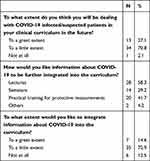 |
Table 6 COVID-19 and University Curriculum |
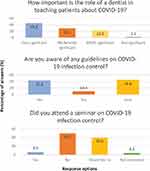 |
Figure 1 Austrian dental students’ knowledge and attitudes on COVID-19 and dentists’ role in tackling the pandemic. |
Table 7 shows the students estimation of the full re-opening of dental services within their curriculum. Overall, 75% of the participants were hoping to be able to return to normal activity in the summer term of 2020, and only 22.9% were expecting a delay until the winter term of 2020/21. The most chosen answer to the question of how to avoid a COVID-19 infection among patients was “Social distancing” with a response rate of 38%, followed by “Frequent disinfection of dental clinics and areas” (21%) and “Wear proper protective equipment” (27%).
 |
Table 7 Opening of Dental Services Within Student’s Curriculum |
Protective measures and equipment used at the Dental School of the Medical University in Vienna are displayed in Table 8. Generally, a vast number of students (81%) suggested to have only a limited number of patients in the waiting room with an adequate distance, whereas 38% would offer appointments in large time intervals and merely 13% would occupy every second dental treatment unit at the clinic.
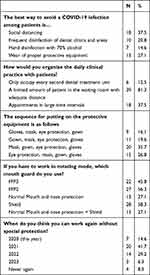 |
Table 8 Protective Measures and Equipment at the Medical University of Vienna |
Only 20% of the students chose the correct sequence for putting on the protective equipment. More than half of the participants use an FFP2 mask when working in rotating mode (56%), followed by 46% who would wear an FFP3 mask and additionally a shield (58%). About 42% of the interviewees think that already in 2021 it might be possible to work without special protection again.
Discussion
Since COVID-19 still poses problems for dentists and institutions such as dental universities in which a significant part of the treatment is done by students in their clinical term, there is great need to provide decision makers with a more systematic way to evaluate the knowledge and practice of its students in their clinical term so that eventual policies can be made before the backdrop of robust data.
Since the COVID-19 infection is a fairly new and not yet fully understood, there are only few studies that evaluate dentists’ knowledge and attitude of the new virus, of which one is conducted in Austria.10,16,17
Our study is the first to examine the knowledge and perception on COVID-19 of dentistry students in Austria, and one of a few international surveys to focus on questioning dentistry students.18–20 This study sought to provide an overview of the student’s perceptions of the novel virus and attitudes to infection control shortly after the first implemented lockdown by the Austrian government. Dentistry students in their clinical courses are in direct contact with patients and therefore at a higher risk to get infected with COVID-19 due to work with rotative instruments and aerosol build up.4 Thus, it is relevant to assess the students’ knowledge and attitudes on this viral disease due to their role in preventing the spread and patient education on COVID-19. A lack of knowledge or faulty attitudes can put the dental staff and the patients’ safety and health at risk and might even affect the functioning of the health care system.
The results of the present study show that Austrian dentistry students in their clinical term of their curriculum generally have a good knowledge of the most salient aspects of the novel virus, even though there are potentially some consequential gaps in their knowledge that need improvement, such as hygienic protocols.
In an age of misinformation and fake news, it was a positive sign that most students (90%) get their information regarding the COVID-19 infection from official sources.21 These results are similar to the findings of a study of Austrian pediatric dentists, where 86% reported that they rely on official sources of the government and also similar to a study of Turkish dentistry students of whom 76% used websites of official entities such as the Ministry of Health and the corresponding social media accounts to expand their knowledge of the disease.14 It slightly differs from the findings of Nigerian students who almost completely relied on social media (99%) and television (81%) for their information.22 Another encouraging finding was the widespread knowledge of the most salient symptoms of COVID-19 and the most typical ways in which the virus spreads.
A further reassuring sign was the common use of either FFP3 (46%) or FFP2 masks (56.3) whilst working with rotatory instruments during dental procedures.
Despite these positive observations a majority (62.5%) of the participants did not feel prepared or were not sure whether they were sufficiently prepared for the novel virus. Indeed, under closer scrutiny of the data a few knowledge gaps showed. A significant number of respondents did not identify all modes of transmission (26%) and it is noteworthy that only 31% were able to correctly identify all COVID-19 symptoms, compared to 53% and 85% of Austrian pediatric dentists respectively.10 This could be explained by the novelty of the virus and is thus somewhat understandable since the study was conducted right during the first lockdown in Austria, when there was not much data on the epidemiology of the virus, but it also shows that students might not feel the same responsibility to educate themselves as already established practitioners.23
In a similar vein, it can be noted that although the majority of students turned to reliable sources for their information about COVID-19, only 44% of the students were aware of guidelines on COVID-19 infection control. Thus, it is not as surprising that only 19.6% of the participants were aware of the correct sequence of properly putting on the protective equipment, which is as follows: Gown, mask, eye protection, gloves.
There was another interesting phenomenon that might have arisen from the limited information available in March and the students’ unique circumstances. We might infer that students were aware that social distancing would reduce the likelihood of infection from their positive answer to the question that only a limited number of patients should be in the waiting room at any one time. With this in mind, it is odd that only a small number of participants gave a positive answer to the question that having only every second treatment unit occupied can reduce the likelihood of infection. The two slightly inconsistent answers might be explained by the pressure on the students to meet the needed curriculum requirement to pass their courses.
These different observations show that although the students know where to find reliable information sources on COVID-19, some of them have not done their due diligence to inform themselves sufficiently. Both of these findings point to the need of the university to play a more active role in the education of their students regarding new diseases, especially since dentistry students in their clinical part of their curriculum are more vulnerable to face or spread an infection of any kind.13 This conclusion has also been reached by two recent papers from Brazil and India.24,25 Behind this backdrop, this study presents a valuable contribution to the literature by providing policy-makers with an overview of the students’ preferences regarding how they would like to be informed about COVID-19. The majority of students reported that they would prefer a lecture (58.3%) or practical training for protective measures (41.7%). Although given the current load of the curriculum, they would prefer their additional knowledge to not have a great impact (72.9%) on their current workload.
Strengths and Limitations
An obvious limitation of this study is its sample size. Only dentistry students of the Medical University of Vienna were included. This might make it difficult to extrapolate to a wider setting since only Viennese students were included. Nevertheless, it can be assumed that students at other universities are facing similar problems. Thus, we recommend to conduct further studies with bigger sample size and include other Austrian universities that offer dentistry programs. Such studies would furthermore allow us to investigate whether students’ knowledge about COVID-19 has improved as the pandemic progressed.
Conclusions
Universities as well as other medical institutions, in which students are provided with dental education, provide policy makers with unique challenges. This study assessed that even though Austrian dentistry students had good knowledge on general information about COVID-19 in the early phase of the pandemic, there is a need for additional educational programs such as lectures or practical courses on infection control. One way to do this is to integrate international guidelines and lectures on preventive measures into the curriculum. Further studies are required to evaluate the students’ knowledge and attitude at a later stage of the pandemic as well as after integrating courses into dental school curricula.
Ethical Approval
In Austria, a survey among experts is the only type of research involving humans that does not need an ethics approval. The internal data protection committee of the Medical University of Vienna is responsible for surveys among students of the university. Approval was given.
Funding
No funding was received.
Disclosure
Prof. Dr. Tanja Stamm reports grants and speaker fees from AbbVie, Sanofi Genzyme, Roche, and Takeda, outside the submitted work. The authors declare that they have no other conflicts of interest in this work.
References
1. Li Q, Guan X, Wu P, et al. Early transmission dynamics in Wuhan, China, of Novel coronavirus-infected pneumonia. N Engl J Med. 2020;382(13):1199–1207. doi:10.1056/NEJMoa2001316
2. Huang C, Wang Y, Li X, et al. Clinical features of patients infected with 2019 novel coronavirus in Wuhan, China. Lancet. 2020;395(10223):497–506. doi:10.1016/S0140-6736(20)30183-5
3. Ioannidis J. The infection fatality rate of COVID-19 inferred from seroprevalence data. medRxiv. 2020. doi:10.1101/2020.05.23.20111419
4. Meng L, Hua F, Bian Z. Coronavirus disease 2019 (COVID-19): emerging and future challenges for dental and oral medicine. J Dent Res. 2020;99(5):481–487. doi:10.1177/0022034520914246
5. Epstein JB, Chow K, Mathias R. Dental procedure aerosols and COVID-19. Lancet Infect Dis. 2020. doi:10.1016/S1473-3099(20)30636-8
6. Sabino-Silva R, Jardim ACG, Siqueira WL. Coronavirus COVID-19 impacts to dentistry and potential salivary diagnosis. Clin Oral Investig. 2020;24(4):1619–1621. doi:10.1007/s00784-020-03248-x
7. Amato A, Caggiano M, Amato M, Moccia G, Capunzo M, De Caro F. Infection control in dental practice during the COVID-19 pandemic. Int J Environ Res Public Health. 2020;17(13):4769. doi:10.3390/ijerph17134769
8. Guo H, Zhou Y, Liu X, Tan J. The impact of the COVID-19 epidemic on the utilization of emergency dental services. J Dent Sci. 2020;15(4):564–567. doi:10.1016/j.jds.2020.02.002
9. American Dental Association. What constitutes a dental emergency? Available from: https://success.ada.org/~/media/CPS/Files/Open%20Files/ADA_COVID19_Dental_Emergency_DDS.pdf.
10. Bekes K, Ritschl V, Stamm T. COVID-19 pandemic and its impact on pediatric dentistry in Austria: knowledge, perception and attitude among pediatric dentists in a cross-sectional survey. J Multidiscip Healthc. 2021;14:161. doi:10.2147/JMDH.S285093
11. World Health Organization. Clinical Management of Severe Acute Respiratory Infection (SARI) When COVID-19 Disease is Suspected: Interim Guidance, 13 March 2020. World Health Organization; 2020.
12. Cianetti S, Pagano S, Nardone M, Lombardo G. Model for taking care of patients with early childhood caries during the SARS-Cov-2 pandemic. Int J Environ Res Public Health. 2020;17(11):3751. doi:10.3390/ijerph17113751
13. Stewardson D, Palenik C, McHugh E, Burke F. Occupational exposures occurring in students in a UK dental school 1. Eur J Dent Educ. 2002;6(3):104–113. doi:10.1034/j.1600-0579.2002.00253.x
14. Ataş O, Yildirim TT. Evaluation of knowledge, attitudes, and clinical education of dental students about COVID-19 pandemic. PeerJ. 2020;8:e9575. doi:10.7717/peerj.9575
15. Machado RA, Bonan PRF, Perez DE, Martelli Júnior H. COVID-19 pandemic and the impact on dental education: discussing current and future perspectives. Braz Oral Res. 2020;34. doi:10.1590/1807-3107bor-2020.vol34.0083
16. Ammar N, Aly NM, Folayan MO, et al. Knowledge of dental academics about the COVID-19 pandemic: a multi-country online survey. BMC Med Educ. 2020;20(1):1–12. doi:10.1186/s12909-020-02308-w
17. Novel CPERE. The epidemiological characteristics of an outbreak of 2019 novel coronavirus diseases (COVID-19) in China. Zhonghua liu Xing Bing Xue Za Zhi. 2020;41(2):145.
18. Gohel KH, Patel PB, Shah PM, Patel JR, Pandit N, Raut A. Knowledge and perceptions about COVID-19 among the medical and allied health science students in India: an online cross-sectional survey. Clin Epidemiol Glob Health. 2021;9:104–109. doi:10.1016/j.cegh.2020.07.008
19. Ozverel CS, Kurtulmus-Yilmaz S. Awareness and perception of dentistry students studying in Cyprus regarding COVID-19: a cross-sectional study. J Contemp Med Sci. 2020;6(5). doi:10.22317/jcms.v6i5.828
20. Almulhim B, Alassaf A, Alghamdi S, et al. Dentistry amidst the COVID-19 pandemic: knowledge, attitude, and practices among the Saudi Arabian dental students. Front Med. 2021;8:400. doi:10.3389/fmed.2021.654524
21. Orso D, Federici N, Copetti R, Vetrugno L, Bove T. Infodemic and the spread of fake news in the COVID-19-era. Eur J Emerg Med. 2020;27(5):327–328. doi:10.1097/MEJ.0000000000000713
22. Umeizudike KA, Isiekwe IG, Fadeju AD, Akinboboye BO, Aladenika ET. Nigerian undergraduate dental students’ knowledge, perception, and attitude to COVID‐19 and infection control practices. J Dent Educ. 2020. doi:10.1002/jdd.12423
23. Plümper T, Neumayer E. Lockdown policies and the dynamics of the first wave of the Sars-CoV-2 pandemic in Europe. J Eur Public Policy. 2020:1–21.
24. Aragao MGB, Gomes FIF, de Melo LPMP, Corona SAM. Brazilian dental students and COVID-19: a survey on knowledge and perceptions. medRxiv. 2020.
25. Arora S, Saquib SA, Attar N, et al. Evaluation of knowledge and preparedness among Indian dentists during the current COVID-19 pandemic: a cross-sectional study. J Multidiscip Healthc. 2020;13:841. doi:10.2147/JMDH.S268891
 © 2021 The Author(s). This work is published and licensed by Dove Medical Press Limited. The full terms of this license are available at https://www.dovepress.com/terms.php and incorporate the Creative Commons Attribution - Non Commercial (unported, v3.0) License.
By accessing the work you hereby accept the Terms. Non-commercial uses of the work are permitted without any further permission from Dove Medical Press Limited, provided the work is properly attributed. For permission for commercial use of this work, please see paragraphs 4.2 and 5 of our Terms.
© 2021 The Author(s). This work is published and licensed by Dove Medical Press Limited. The full terms of this license are available at https://www.dovepress.com/terms.php and incorporate the Creative Commons Attribution - Non Commercial (unported, v3.0) License.
By accessing the work you hereby accept the Terms. Non-commercial uses of the work are permitted without any further permission from Dove Medical Press Limited, provided the work is properly attributed. For permission for commercial use of this work, please see paragraphs 4.2 and 5 of our Terms.
